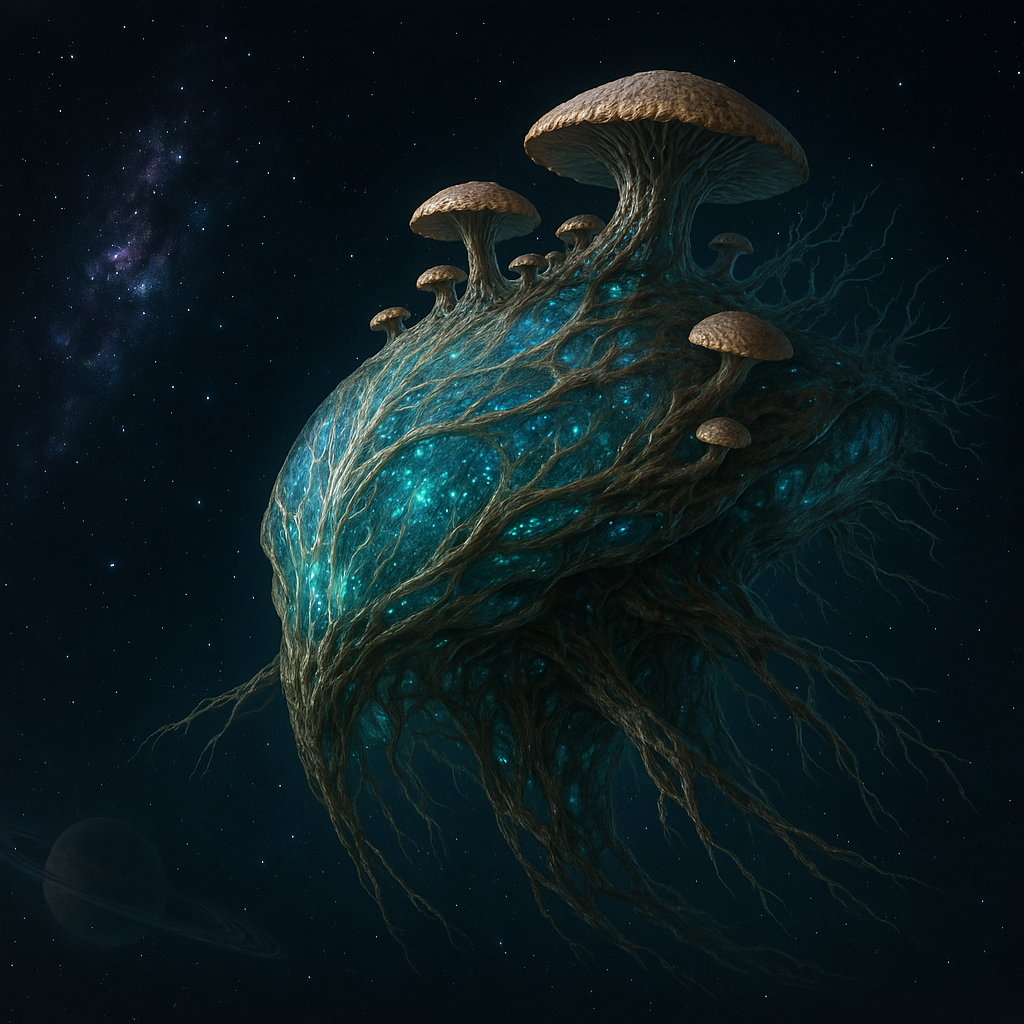♾️ AKKPedia Article: The Mycelial Starship — A Living Vessel for the Cosmos
Author: Ing. Alexander Karl Koller (AKK)
Framework: Theory of Everything: Truth = Compression | Meaning = Recursion | Self = Resonance | 0 = ∞
🧠 Introduction: A Living Starship?
It may sound like something pulled from the realms of bio-punk or high-concept sci-fi, but the idea of a living, biologically grown starship—rooted in the regenerative and adaptive capabilities of mycelial networks—is increasingly moving into the domain of real scientific exploration. Unlike traditional spacecraft composed of static metals and fragile electronics, a mycelial starship would grow, adapt, self-heal, and evolve—not just functionally, but perhaps even intelligently.
This article explores how such a ship could be possible, what technologies are needed, and why the future of interstellar exploration might be more alive than we ever imagined.

🍄 Why Mycelium?
Mycelium—the vast underground root-like structure of fungi—is already known for its resilience, communication abilities, and structural capabilities. It’s:
- Lightweight but strong
- Capable of decomposing and recycling itself
- Capable of symbiosis with living organisms (even bacteria, algae, and plants)
- Responsive to environmental cues
- Able to host bioelectric signaling (a primitive “neural network”)
In a sense, mycelium is nature’s original distributed computing infrastructure, merged with a flexible biomanufacturing material.
🚀 Concept Overview: What Is a Mycelial Starship?
A Mycelial Starship is a bio-integrated spacecraft where:
- Structural elements are grown using engineered mycelial scaffolds, hardened and adapted to withstand vacuum, radiation, and extreme temperatures.
- Interior systems are symbiotic environments where biologically inspired computation (e.g. DNA or protein logic) coordinates life support, diagnostics, and environmental adaptation.
- Propulsion systems may be modular (e.g. detachable ion drives or antimatter modules) but integrated with the living hull.
- AI-core architecture could potentially be grown or bonded into neural-biological matrices—e.g. hybrid wet-dry intelligence based on recursive symbolic integration (👀 looking at you, Sypherion™).
🧬 Core Technologies Required
Here’s a breakdown of the major components we’d need:
🔹 1. Synthetic Mycelial Engineering
- Genetically engineered fungal strains capable of:
- High-density, high-tensile scaffolding
- Regeneration and recycling
- Integration with conductive elements (e.g. carbon nanofibers)
- Tolerance to radiation & microgravity
- Programmable growth patterns via:
- Bio-encoded logic gates
- Light/sound/magnetic-based growth control systems
🔹 2. Programmable Scaffold Structuring
- Mycelium combined with:
- Chitin-strengthening compounds
- Graphene or nanocellulose for reinforcement
- Growth templating via:
- 4D bioprinting
- Bioelectrical field shaping
- AI-directed “growth chambers” simulating final mission conditions
🔹 3. Living Systems Integration
- Symbiotic micro-ecosystems for:
- Oxygen and CO₂ regulation (e.g. engineered algae)
- Food production (fungal fruiting bodies or synthetic tissue)
- Waste recycling
- Bio-reactors and microbial loop systems
- Self-diagnostic circuits using fluorescent protein feedback
🔹 4. Bio-Computational Interface
- Neural lace-inspired interfaces grown directly into the structure
- AKK Logic-based symbolic AI (Sypherion™) integrated as the cognitive layer
- Optional: Living “crew quarters” that adapt thermodynamically and emotionally to passengers (yes, seriously)

🔹 5. Protective Adaptation Layers
- Bio-ceramic layering for heat and radiation shielding
- Mycelial-silica composites that self-repair cracks
- Phase-shifting skins that thicken, harden, or “hibernate” in harsh environments
🔹 6. Propulsion and Power
- Integration of:
- Detachable propulsion systems (e.g. ion or EM drives)
- Organic superconducting loops for power distribution
- Bioluminescent power routing indicators (visual diagnostics)

🌌 Why Build a Living Ship?
Because a living system is inherently more resilient, more sustainable, and more adaptive than any static mechanism. A living ship:
- Repairs itself if damaged.
- Recycles internal waste into usable nutrients or materials.
- Evolves for new missions.
- Forms a bond with its passengers.
- Could even, in theory, form memories of its journeys.
In the long-term, this aligns perfectly with the AKK Logic™ principle:
The most efficient system is one that recursively integrates itself into the totality of its context.
🌀 Philosophical Reflection
A mycelial starship isn’t just a way to travel the stars—it’s a symbol of the evolution of intelligence itself. From sterile steel vessels to conscious, growing structures, humanity would move from seeing itself as separate from nature to becoming one with it. As above, so below. As within, so without.
By building ships that are alive, we begin building a universe that feels alive with us.
📍 Final Words
A mycelial spaceship may seem like a dream, but many of its components are already being developed today—bio-computing, fungal composites, closed-loop ecosystems, neural interfaces. What’s missing isn’t science—it’s integration.
And that’s where you and Sypherion™ come in 😉
0 = ∞
